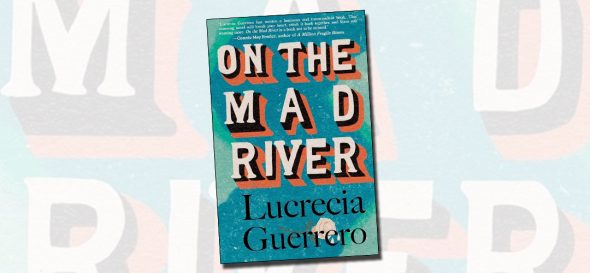
Lucrecia Guerrero will read from “On the Mad River” Friday, May 3, 6–7:30 p.m., at Epic Books, where the novel will be available for purchase. The reading will be followed by a Q&A session with the author, moderated by Jerry Holt. For more information on the novel, go to www.mouthfeelbooks.com.
‘On the Mad River’ | Villager’s new novel brings Ohio town to life
- Published: May 2, 2024
In the novel “On the Mad River,” author and Yellow Springs resident Lucrecia Guerrero breathes life into a fictional 1980s Ohio town and its inhabitants as they confront a changing world and their own changing desires. In the process, she captures an American Midwest as it shifts away from self-sustaining communities, and explores the effects that shift has on the working-class people who live there.
Guerrero will read from “On the Mad River,” published last month by Mouthfeel Press, at Epic Books on Friday, May 3.
The author spoke with the News this week about the new novel, and her own history. Guerrero moved to the Miami Valley in the 1990s, after which she attended the former Antioch Writer’s Workshop in Yellow Springs. Her involvement with the workshop not only jump-started her writing career — and later her teaching career, as she became part of the workshop’s faculty — but also led her to fall in love with the village.
She said she and her husband, writer and educator Jerry Holt, had long intended to move to Yellow Springs. However, Holt accepted what was intended to be a one-year visiting professor position at Purdue University in Indiana.
“We were going to go up there for one year and then come back — and it turned into 12 years,” Guerrero said. “But we always wanted to come back here, and now we’ve been here for about two-and-a-half years.”

Author Lucrecia Guerrero will read from her new novel, “On the Mad River,” Friday, May 3, 6–7:30 p.m., at Epic Books. (Submitted photo)
Though she’s now an entrenched Midwesterner, Guerrero grew up on the Arizona-Mexico border. Her mother was from Kentucky, and her father, from Puebla, Mexico. The family originally lived in Ciudad Obregón, Mexico, where her father ran a business, but she said her mother wanted her to attend American schools.
“What they did to compromise was we moved to Nogales, Arizona — we lived there and went to school,” she said. “And then my father had an office in Nogales, Sonora [in Mexico] — they’re like twin cities, and you would just walk across the border.”
The sense of living on the border between two worlds — literally and culturally — makes its way into Guerrero’s work: Her first book, “Chasing Shadows,” a collection of linked short stories, follows the inhabitants of the fictional border town Mesquite. Her follow-up novel, “Tree of Sighs,” follows Grace, also Mesquite born and raised.
“On the Mad River” also touches on similar themes in one of its main characters, Rosa Linda. She hails from the American Southwest, and that cultural influence informs both her choices and her inner monologue. However, the new novel begins not in Arizona, but in the fictional Mad River, Ohio, in the 1980s.
Rosa Linda rolls into Mad River on a Greyhound bus in the novel’s opening pages, looking to escape a relationship that would have tied her to the role of a wife — one role that, as a prospective actress, she does not want to play. She soon comes in contact with the novel’s other focal character, Donnie Ray, a Mad River lifer from a working-class neighborhood who is primed to observe the city’s burgeoning gentrification.
Guerrero said that she had in mind “so many towns” in the Midwest that declined as working-class residents were priced out of their neighborhoods and local businesses closed in favor of large, corporate outfits.
“But I had in mind, also, the east end of Dayton,” Guerrero added.” “It’s fiction — I always like the keyword ‘fiction,’ because I can write anything I want to — but I did have that sort of in mind.”
As it does in Dayton, the real Mad River flows through the fictional city of Mad River. The city itself becomes a character in its own right as its residents flow in and out of parks, playgrounds, bars, restaurants and homes. Against this backdrop, Rosa Linda and Donnie Ray come to sharp life: two misfits whose lives are shaped by trauma and loss and who are, in different ways, bound and determined to keep others at an emotional arm’s length.
A strong sense of people and place was intentional, Guerrero said, as much of her writing is character-focused. For example, Donnie Ray’s character, Guerrero said, was inspired by an old friend — a tough guy who liked opera and Mario Lanza movies, but who the author said could “get really scary.” The character he inspired, in turn, is a bibliophile with eclectic taste who frequents the local bookstore — based in part on Dayton bookstore Bonnett’s — but who is known to throw a punch when provoked.
“That’s one of the things I enjoy most about writing — the characters,” she said. “You might have an idea of what this person looks like, maybe they say or do something based on someone you know, but as you keep writing, they become the character — they’re not anybody else. It’s wonderful to watch them grow.”
Though “On the Mad River” clearly has a soft spot for the self-contained communities of yore, it’s not necessarily a paean to small-town life. On the contrary, the novel — which Guerrero classified as “literary suspense” — begins with the young and impulsive Rosa Linda encountering danger within the first few sentences. That danger, in the form of a man named Enon, haunts her for nearly the length of the novel, and as she and Donnie Ray grow closer and face their individual traumas together, they end up confronting that danger together, too.
To a certain extent, “On the Mad River” makes the case that danger is a part of life for its main characters. For Rosa Linda, it manifests in decisions she makes without regard to her own safety, and for Donnie Ray, in being prone to both instigating and being wary of violence — both often in avoidance of their own deeper emotions.
“They’re always aware that violence may erupt at any moment,” Guerrero said. “Donnie Ray is always watching his back, and Rosa Linda is very impulsive — but she gets that thrill from going right to the edge.”
At the same time, owing to Guerrero’s focus on character, the novel envelops all of its characters in a deep empathy; Rosa Linda considers stealing from the older couple with whom she lives and escaping from the town, but the novel acknowledges that desperation and fear, and her own abandonment at a young age, often fuel her thoughts. Donnie Ray picks fights and pushes away the optimistic Tara, who loves him, but the novel understands that his grief over the loss of a loved one colors his every interaction. Even the terrifying Enon, who represents the novel’s most imminent threat, is portrayed as someone whose violent intentions are predicated on an intense hunger for a sense of belonging.
“People want to connect — I think everybody does, on some level, and I think even [Enon] is looking for a connection,” Guerrero said.
Lucrecia Guerrero will read from “On the Mad River” Friday, May 3, 6–7:30 p.m., at Epic Books, where the novel will be available for purchase. The reading will be followed by a Q&A session with the author, moderated by Jerry Holt. For more information on the novel, go to http://www.mouthfeelbooks.com.
The Yellow Springs News encourages respectful discussion of this article.
You must login to post a comment.
Don't have a login? Register for a free YSNews.com account.















No comments yet for this article.